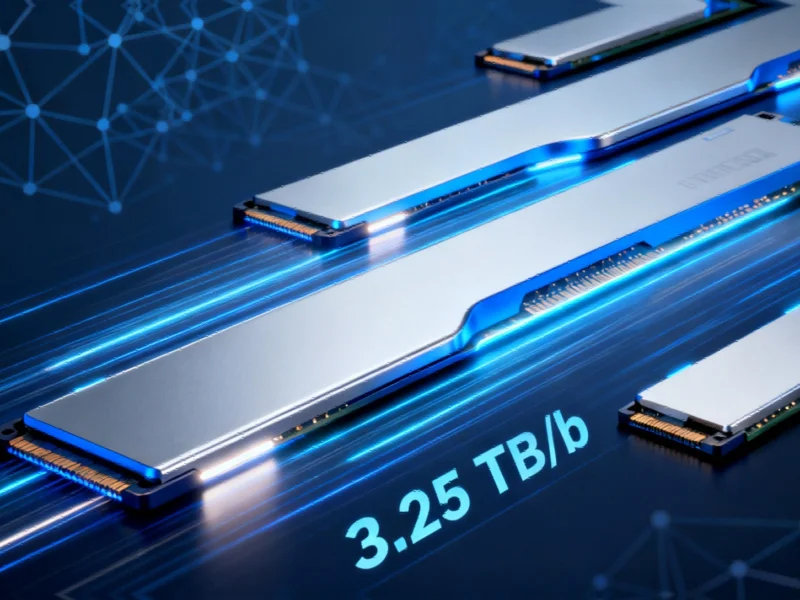Samsung Accelerates AI Revolution with Next-Generation HBM4E Memory
Samsung has positioned itself at the forefront of high-bandwidth memory innovation, becoming one of the first manufacturers to reveal substantial progress on HBM4E technology at the Open Compute Project Global Summit. The Korean semiconductor giant’s latest advancement represents what industry experts are calling a quantum leap in memory performance, with the HBM4E module projected to deliver staggering bandwidth of 3.25 TB/s – nearly 2.5 times faster than current HBM3E solutions. This development comes at a crucial time when Samsung’s next-generation HBM4E memory promises breakthrough AI performance across multiple computing sectors.
The timing of Samsung’s announcement aligns perfectly with the industry’s escalating demands for more powerful AI computing infrastructure. Following significant contract wins with NVIDIA and AMD, Samsung has demonstrated remarkable agility in responding to market needs. The company’s HBM4E will achieve these unprecedented speeds through a per-stack performance of 13 Gbps, while simultaneously delivering nearly double the power efficiency compared to existing HBM3E modules. This combination of raw performance and energy optimization addresses two critical challenges facing next-generation AI systems.
Technical Specifications and Performance Metrics
Samsung’s HBM4 process has already achieved impressive technical milestones, reaching pin speeds of 11 Gbps that substantially exceed standards set by governing bodies like JEDEC. The progression to HBM4E represents the next evolutionary step, building upon this foundation with enhanced architecture and refined manufacturing processes. The 3.25 TB/s bandwidth capability positions Samsung’s solution as a game-changing technology for AI training clusters, high-performance computing applications, and advanced data analytics platforms.
The power efficiency improvements deserve particular attention, as thermal management and energy consumption have become limiting factors in data center scaling. Samsung’s claims of nearly doubled efficiency compared to HBM3E could translate to significant operational cost savings for enterprise AI deployments while enabling more compact system designs. This advancement mirrors similar innovations seen across the computing landscape, where advanced computing environments are preventing performance bottlenecks through evolving architectures.
Market Context and Competitive Landscape
Samsung’s accelerated HBM4E development appears directly responsive to NVIDIA’s specific request for enhanced HBM4 solutions to power its upcoming Rubin architecture. This customer-driven innovation approach demonstrates how close collaboration between memory manufacturers and chip designers is becoming increasingly crucial for pushing computational boundaries. The achievement positions Samsung favorably in the intensifying competition for AI infrastructure supremacy.
The broader industry context shows similar rapid advancements across multiple technology domains. As Microsoft unleashes its AI-first Windows strategy, the demand for high-performance memory solutions continues to accelerate. Samsung’s ability to deliver such substantial generational improvements in both performance and efficiency underscores the company’s manufacturing expertise and technological leadership in the memory sector.
Implementation Timeline and Industry Impact
While Samsung has not provided specific commercialization dates, industry observers expect HBM4E sampling to begin within the next 12-18 months, with volume production likely following in 2026. This timeline aligns with projected launches of next-generation AI accelerators and high-performance computing platforms that will require such advanced memory capabilities.
The implications extend beyond traditional computing applications into emerging technology sectors. As enterprise computing solutions continue to evolve and immersive technologies like VR demand increasingly sophisticated computing resources, Samsung’s HBM4E could enable previously impossible applications and user experiences. The memory technology’s bandwidth capabilities are particularly well-suited for handling the massive datasets required for advanced virtual reality environments and real-time AI inference.
Manufacturing and Supply Chain Considerations
Samsung’s achievement comes amid intense global competition in semiconductor manufacturing. The company’s ability to deliver such advanced memory technology reinforces its position in the ongoing technological race. This development occurs alongside TSMC’s efforts to ramp up American chipmaking ambitions, highlighting how memory and logic semiconductor advancements are progressing in parallel to support the next generation of computing infrastructure.
The manufacturing process for HBM4E involves significant technical challenges, including thermal management of stacked memory dies and maintaining signal integrity at extremely high data rates. Samsung’s success in overcoming these hurdles suggests the company has made substantial progress in both materials science and packaging technology, potentially giving it a competitive edge in the high-margin premium memory market segment.
Future Outlook and Industry Transformation
Samsung’s HBM4E announcement represents more than just another incremental improvement in memory technology – it signals a fundamental shift in what’s possible for AI and high-performance computing systems. The nearly 2.5x performance leap over HBM3E, combined with dramatically improved power efficiency, could accelerate AI model training times, enable more complex neural networks, and reduce the total cost of ownership for large-scale AI deployments.
As the industry moves toward increasingly data-intensive applications, from generative AI to scientific simulations, Samsung’s HBM4E technology provides a glimpse into the memory architecture that will power the next decade of computational innovation. The company’s early leadership in this space positions it to capture significant market share in the rapidly expanding AI infrastructure ecosystem, while pushing the entire industry toward higher performance standards and more efficient computing paradigms.
Based on reporting by {‘uri’: ‘wccftech.com’, ‘dataType’: ‘news’, ‘title’: ‘Wccftech’, ‘description’: ‘We bring you the latest from hardware, mobile technology and gaming industries in news, reviews, guides and more.’, ‘location’: {‘type’: ‘country’, ‘geoNamesId’: ‘6252001’, ‘label’: {‘eng’: ‘United States’}, ‘population’: 310232863, ‘lat’: 39.76, ‘long’: -98.5, ‘area’: 9629091, ‘continent’: ‘Noth America’}, ‘locationValidated’: False, ‘ranking’: {‘importanceRank’: 211894, ‘alexaGlobalRank’: 5765, ‘alexaCountryRank’: 3681}}. This article aggregates information from publicly available sources. All trademarks and copyrights belong to their respective owners.



